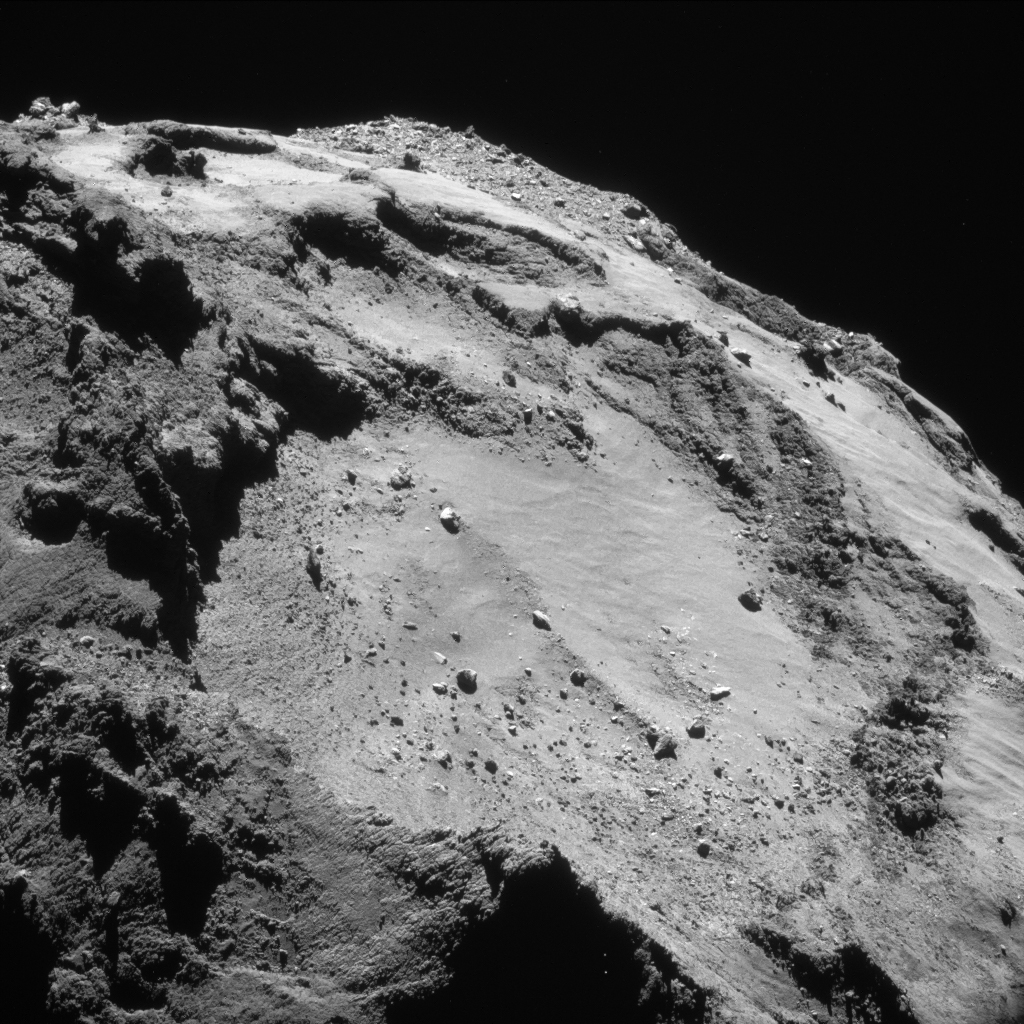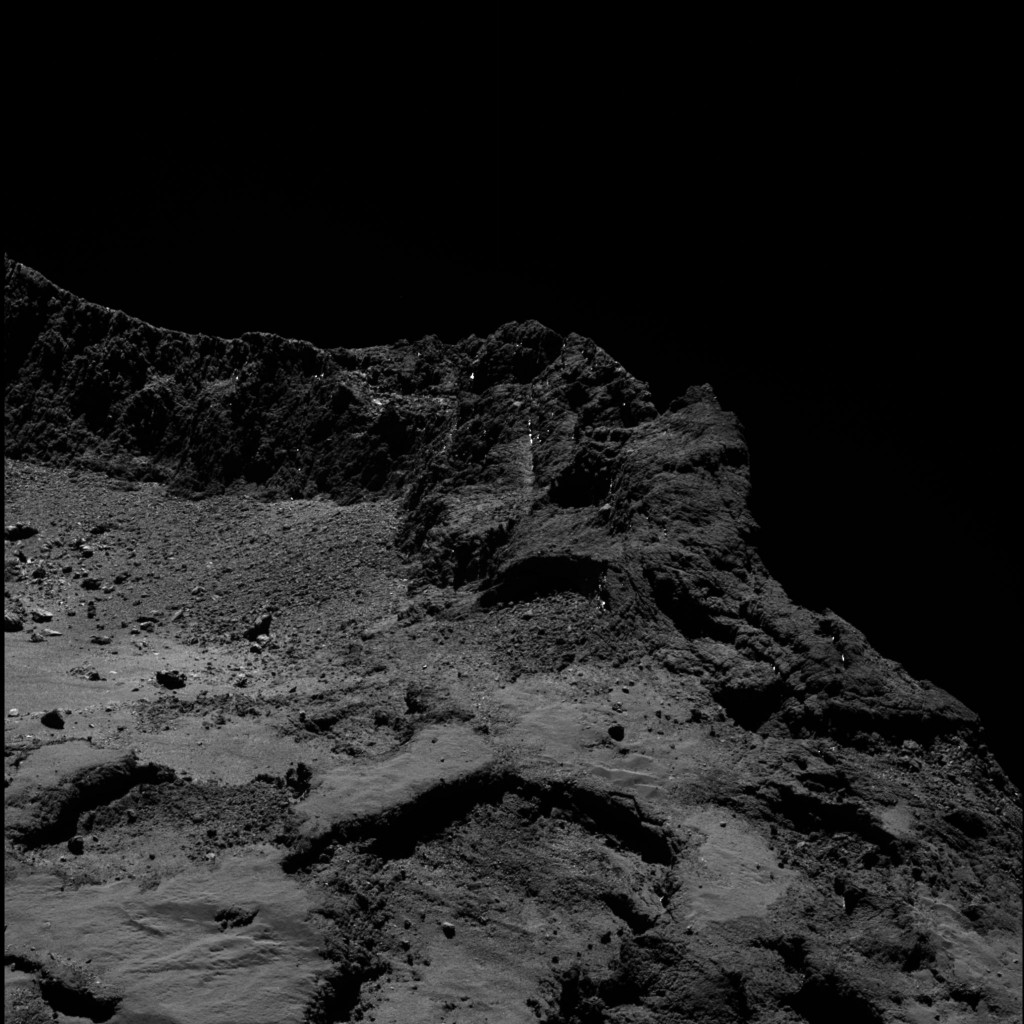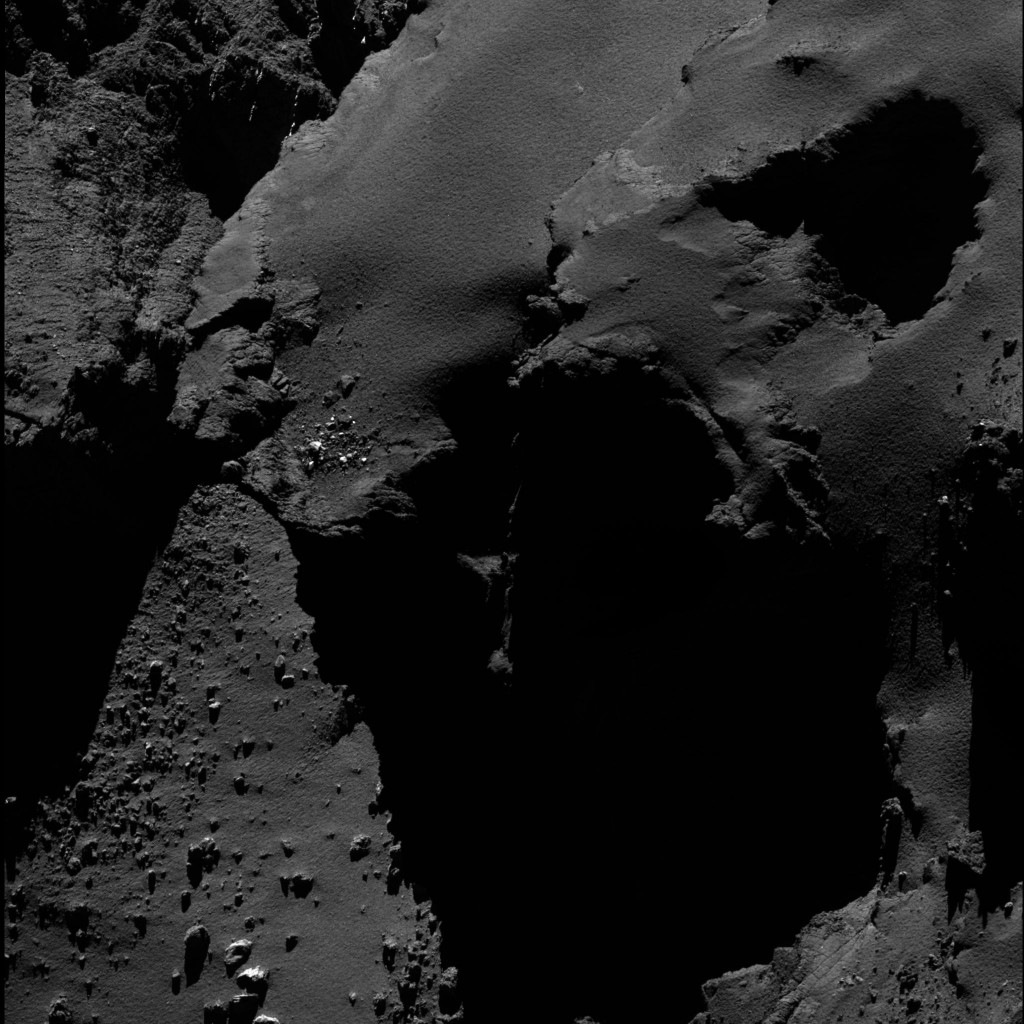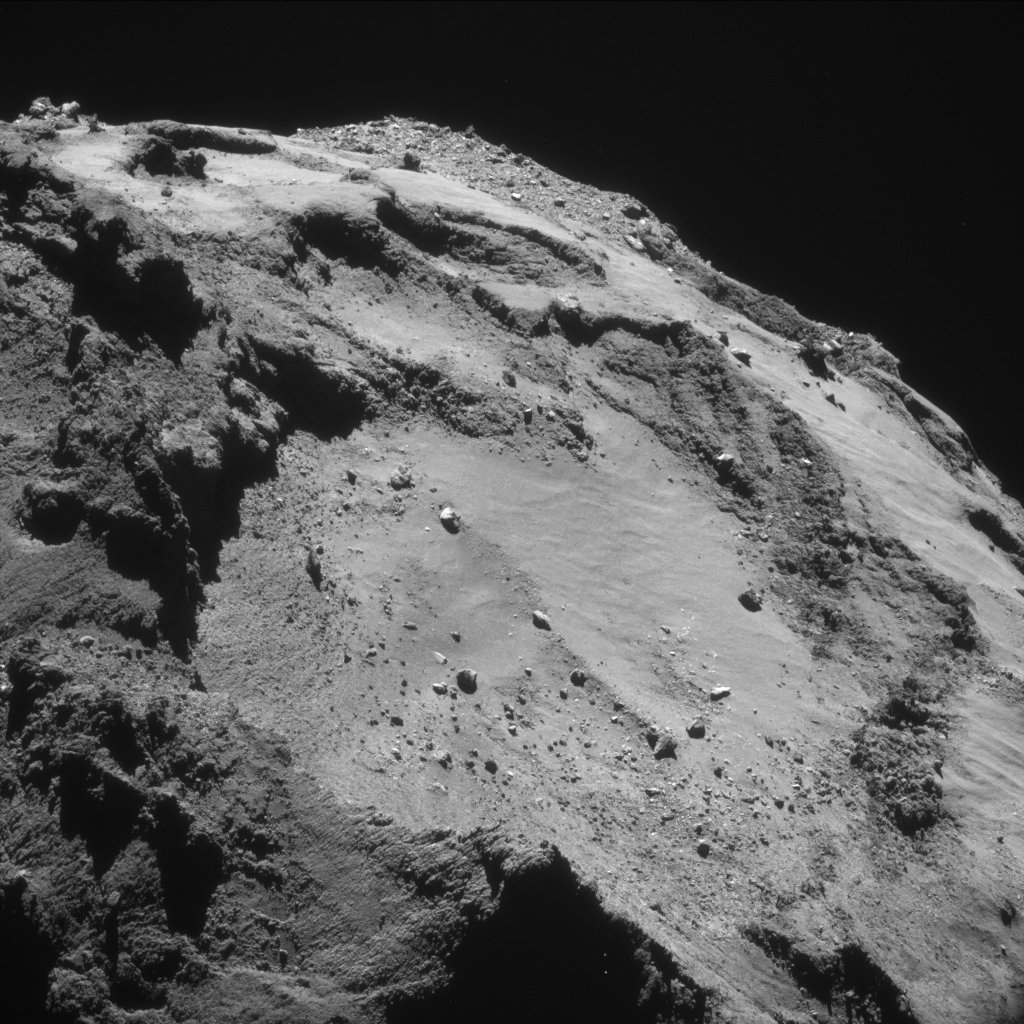This week’s CometWatch is an image taken by Rosetta’s NAVCAM on 15 March, when the spacecraft was about 13 km from the nucleus of Comet 67P/Churyumov-Gerasimenko.

Enhanced NAVCAM image of Comet 67P/C-G taken on 15 March 2016, about 13 km from the nucleus. The average scale is 1.1 m/pixel and the image measures about 1.1 km across. Credits: ESA/Rosetta/NAVCAM – CC BY-SA IGO 3.0
The image shows a portion of the small comet lobe, centred on the large depression in the Hatmehit region. The basin and the declining slopes adjacent to it appear to be covered in smooth material, as well as a multitude of boulders of various sizes.
Parts of the neighbouring regions are also visible in this view: the rough terrains of Maftet to the top left; the smoother Ma’at, blanketed in dust, just above and to the right of Hatmehit in this view; and a hint of the Nut region, heavily covered with boulders, on the top edge.
A close-up view on the Hatmehit region, taken with Rosetta’s OSIRIS narrow-angle camera on 5 March, was also released last week via the OSIRIS image of the day website. Snapped from a different perspective, the OSIRIS view reveals the other side of the cliff that is featured in the lower part of the NAVCAM image.

OSIRIS narrow-angle camera image taken on 5 March 2016, when Rosetta was 20.3 km from the comet. The scale is 0.36 m/pixel and the image measures about 0.7 km across. Credit: ESA/Rosetta/MPS for OSIRIS Team MPS/UPD/LAM/IAA/SSO/INTA/UPM/DASP/IDA
Another narrow-angle camera OSIRIS image, taken on 12 March and released yesterday, offers a beautiful view on more of the comet’s boulders, this time in the Hapi region, on the neck of 67P/C-G. In this orientation, the small comet lobe is in the foreground, occupying the central and right parts of the image, while hints of the large lobe and neck can be seen on the left.
On the small lobe, it is possible to see parts of the smooth, dust-covered terrains of Ma’at, with a cluster of boulders close to the edge. The lower left part of the image displays the smooth dust and large boulders sprinkled over the Hapi region, and a small portion of Babi can be seen in the upper left corner.

OSIRIS narrow-angle camera image taken on 12 March 2016, when Rosetta was 17.7 km from the comet. The scale is 0.31 m/pixel and the image measures about 0.6 km across. Credit: ESA/Rosetta/MPS for OSIRIS Team MPS/UPD/LAM/IAA/SSO/INTA/UPM/DASP/IDA
The original NAVCAM image is provided below.










Discussion: 10 comments
Wonderfull pictures again. 31 centimeters per pixel ! It’s time to shows us Philae…
Ignoring for once the scientific aspects.
These superb images, like many others, have a strong aesthetic value too.
To me they have a sort of brooding, sometimes almost threatening air about them. Of course one’s knowledge of the alien environment, antithetical to live, informs that impression. The stark black-and-White reinforces it too.
But I wonder how others see them, from a purely aesthetic viewpoint for once? Here there are no rights and wrongs!
Like your view Harvey!
So so far beyond the “dirty iceball” concept! Just spectacular.
I’m finding it very interesting how little appears to have changed. Familiar landmarks are still there, such as the same pattern of big lumps along the edge of the scarp that’s still hidden under the dust, in Hatmehit.
I haven’t done any detailed comparisons, but I was expecting more obvious disturbances. I have this impression that it is a little more “groomed” looking, like a sandy, pebbly, rocky beach right after a storm has smoothed everything out, but I haven’t made any real close study comparing the post with the pre perihelion images.
Judy
Yes, I agree. For such ‘drama’, the changes seem surprisingly subtle.
I guess there are a couple of confounding factors that tend to ‘trick the eye’.
Firstly we see the ‘jets’ as big ‘violent’ dramatic things. But they have been contrast enhanced, & in fact are pretty tenuous, low density events, nothing like say a dense high pressure volcanic ash jet, which its easy to see casual similarity too.
Secondly, resolution. We are now back at ~0.3m/pixel, but until now many post perihelion images are more like metres/pixel (the top one here is 1.1m/pix) So changes on a metre scale are only just becoming decently resolved.
But that said I reinterate broadly I agree; I think many of us expected more obvious surface remodelling.
Hi Judy,
Having viewed the more recent OSIRIS images obtained from as close as 11Km I find your analogy to a beach quite apt. Many areas previously referred to as “dusty” seem to resemble a shingle beach. The appearance of what seem to be “dunes” in the Hapi region would suggest a smaller grain size than that, although with such a very low gravity even large stone sized lumps might still be mobile enough to form “dunes” I suppose. The close up images of the surface from Philae certainly suggests a surface of stones and gravel, although clearly not the smooth, rounded shapes of pebbles on a beach. Everything on 67P seems angular and sharp, l guess because of the “rock hard” crystalline nature of the frozen volatiles and the lack of erosion by fluids.
Harvey I agree with your sentiments also. The stark ruggedness of the terrain has it’s own beauty and attraction and now the large scale scientific mysteries of a comet have been revealed these unique images are what still excites me most about this mission. Although Curiosity has given us some stunning images from the surface of Mars, they seem all to familiar, not unlike many desert regions on Earth. These images are most definitely of an alien world. I certainly intend to make another couple of videos when all the close up OSIRIS images are available.
Hi Judy,
You are absolutely right in your point – There should be wholesale obvious texture transformations on many surfaces that showed activity. If the mission scientists had gone to the effort of deciding names for features in the way they have for dust particles, it would be easier to talk about how one or another (or in this case none of them) have disappeared, changed, or in any way look different.
Texture is something that one can perceive beyond the resolution of the images. small erosional effects, even of millimetres, will expose or cover things with slightly different reflectivity and we would perceive this as a textural transformation.
Agree with Marco that more names would help identification.
hy judy,
I think thats verry great photo.. Thank you and best regards.